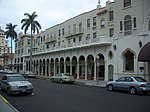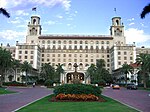Palm Beach is an incorporated town in Palm Beach County, Florida. Located on a barrier island in east-central Palm Beach County, the town is separated from West Palm Beach and Lake Worth Beach by the Intracoastal Waterway to its west and a small section of the Intracoastal Waterway and South Palm Beach to its south. As of the 2020 census, Palm Beach had a year-round population of 9,245, an increase from 8,348 people in the 2010 census. An additional 25,000 people reside in Palm Beach annually between November and April.
The Jaega arrived on the modern-day island of Palm Beach approximately 3,000 years ago. Later, white settlers reached the area as early as 1872, and opened a post office about five years later. Elisha Newton "Cap" Dimick, later the town's first mayor, established Palm Beach's first hotel, the Cocoanut Grove House, in 1880, but Standard Oil tycoon Henry Flagler became instrumental in transforming the island of jungles and swamps into a winter resort for the wealthy. Flagler and his workers constructed the Royal Poinciana Hotel in 1894, The Breakers in 1896, and Whitehall in 1902; extended the Florida East Coast Railway southward to the area by 1894; and developed a separate city to house hotel workers, which later became West Palm Beach. The town of Palm Beach incorporated on April 17, 1911. Addison Mizner also contributed significantly to the town's history, designing 67 structures between 1919 and 1924, including El Mirasol, the Everglades Club, La Querida, the William Gray Warden House, and Via Mizner, which is a section of Worth Avenue.
Forbes reported in 2017 that Palm Beach had at least 30 billionaires, with the town ranking as the 27th-wealthiest place in the United States in 2016 according to Bloomberg News. Many famous and wealthy individuals have resided in the town, including United States presidents John F. Kennedy and Donald Trump. Palm Beach is known for upscale shopping districts, such as Worth Avenue, Royal Poinciana Plaza, and the Royal Poinciana Way Historic District.










